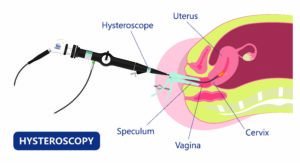Uterine cancer is a type of cancer that starts in the uterus. The uterus is situated in the lower part of your pelvis. It is a hollow and pear-shaped organ wherein the embryo and fetus develop during pregnancy.
Usually, uterine cancer begins in the cells that line the innermost layer of your uterus (endometrium). That’s why it is also called endometrial cancer.
However, sometimes cancer can begin in the cells that line the muscular wall of your uterus (myometrium). This type of uterine cancer is called uterine sarcoma. It is rare than endometrial cancer and comparatively difficult to treat.
You can experience the following uterine cancer symptoms:
Doctors and researchers aren’t sure about what causes uterine cancer. What is known, however, is that some mutations take place in the DNA of the cells located in the uterus.
These mutations cause the cells in your uterus to grow and multiply quickly. The abnormal cells form a tumour, kill the healthy cells, and lead to uterine cancer. Eventually, they also separate and metastasise (spread within your body).
The following factors can increase your chance or act as a uterine cancer cause:
Having cancer can feel terrifying. But the silver lining is that it can be treated – provided you don’t delay consulting a doctor if you experience any uterine cancer symptoms.
In consultation, a doctor asks about your health history and recommends a pelvic exam. Besides this, the doctor usually runs the following procedures and tests to check for uterine cancer:
A doctor inserts a flexible tube in your uterus through your cervix to remove a sample of uterine tissues from the endometrial lining. Then a pathologist analyses it under a microscope to check for abnormal cells and uterine cancer.
This procedure is carried out with the help of a hysteroscope – a thin tube that passes through your cervix and vagina to reach your uterus. It is attached to a camera and light source that help to transmit images of your uterus on a monitor screen to look for uterine cancer.

To double-check the diagnosis of uterine cancer – D&C is carried out. In this procedure, tissue is removed from your uterine lining and assessed under a microscope to check for uterine cancer.
After the diagnosis of uterine cancer comes out to be positive, our doctor will conduct imaging tests – CT scan, a transvaginal ultrasound, MRI scan, chest X-ray, etc. – to know exactly how far the cancer has spread (metastasised).
The knowledge of metastasis helps categorise cancer in one of the following uterine cancer stages:
The treatment will depend on the stage and type of uterine cancer you suffer from. Generally, endometrial cancer is easier to treat than uterine sarcoma. Both types of uterine cancer can include any one of the following treatments.
Depending on the extent of the spread of cancer – the following surgeries can be carried out:
This surgery involves removing your uterus and cervix with the help of an incision in your abdomen. When both organs are removed through your vagina, this surgery is known as a vaginal hysterectomy.
Whereas, when both organs are removed with the help of a laparoscope, this surgery is known as total laparoscopic hysterectomy.
This surgery involves removing portions of your vagina along with the cervix and uterus.
If a hysterectomy has taken place, but uterine cancer has already spread to your fallopian tubes and ovaries, this surgery is used to remove both organs.
When cancer has already spread to lymph nodes after a hysterectomy, this surgery is used to remove them and check for further spread of cancer.
This uterine cancer treatment involves killing cancerous cells with drugs that can be administered through a vein or by taking pills.
This therapy uses substances produced by your body or in a lab to boost your immune system and help it fight uterine cancer.
This therapy involves using strong energy beams or radiation beams to target cancer cells and destroy them.
Sometimes, cancer cells feed on hormones for their growth. In hormone therapy, medicines are used to lower those hormone levels that help uterine cancer grow so that the cancer cells eventually die.
This therapy involves the identification of weaknesses within cancer cells and targeting them with the drugs to destroy them.
By making a few changes in your life, you can significantly lower your risk of suffering from uterine cancer:
Uterine cancer often starts in the cells that line your uterus’s inner layer. But sometimes, it can begin in the cells surrounding your uterus’s muscular wall. It is accompanied by spotting between periods, vaginal bleeding after menopause, overwhelming pelvic pain, etc. Experiencing these symptoms can feel scary, so it’s best to consult a doctor as soon as possible to check for the possibility of uterine cancer.
Our cancer specialists at CK Birla Hospital understand that even the possibility of suffering from uterine cancer can be unsettling. Thus, we aim to provide compassionate healthcare services with the help of a multidisciplinary team-based approach and cutting-edge technologies. We also perform safe and precise robot-assisted surgeries.
So, if you experience any symptoms of uterine cancer and wish to get a diagnosis and eventually treatment, you can visit the oncologists at the CK Birla Hospital or book an appointment with .